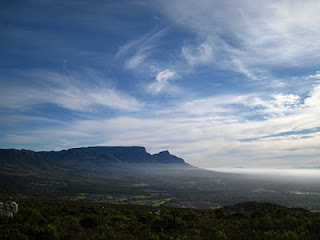 A birthday walk on Sunday, a weather forecast gone very wrong and a pack of dogs scaling a mountain. Just another day on Table Mountain.
A birthday walk on Sunday, a weather forecast gone very wrong and a pack of dogs scaling a mountain. Just another day on Table Mountain.It was Mike’s 60th and although he seemed to start off a bit gloomy, the mountain soon had him in birthday mood.
The weather forecast was way off. The Sunday newspaper said 27 degrees, but you only had to look out the window to know that forecast was for another city in another hemisphere. Never be under-equipped, is Jannie’s mantra and I know not to argue with him. But gloves! Which mountain was he preparing for?
As it turned out, Table Mountain. Halfway up Constantia Corner the weather turned icy. More like -27. OK, 16 degrees. Mist swirled in, the sun disappeared and so did the people and dogs just ahead of me on the path.
Karen was leading our pack of (unsubservient) humans and (subservient) dogs up to Camel Rock from Constantia Corner. This route is misleading. It looks easy because you never see the whole route ahead of you, but my calves are still hurting a day later. Karen’s pack of dogs, from small to large, were scrambling up the mountain with various degrees of help from human hands.
 At the top we found shelter for morning tea under those beautiful weathered rocks, chiselled away by the exact same wind and mist that was swirling around us.
At the top we found shelter for morning tea under those beautiful weathered rocks, chiselled away by the exact same wind and mist that was swirling around us.Walking in the mist makes the mountain soft, mysterious; things look different. It’s like a woman wearing a veil.
But we didn’t linger. By noon we were sitting in Barristers, sharing a bottle of red wine and a few beers. Now it didn’t matter what the weather forecast was, we had a birthday to celebrate.







 Something strange greeted us in the east when we woke up on Sunday morning. It was the sun. Almost unseen for the past two weeks, it made its re-appearance with a mad jumble of red and pink clouds streaked across the horizon. Every last shred of grey rain and cold was gone. It was a beautiful day.
Something strange greeted us in the east when we woke up on Sunday morning. It was the sun. Almost unseen for the past two weeks, it made its re-appearance with a mad jumble of red and pink clouds streaked across the horizon. Every last shred of grey rain and cold was gone. It was a beautiful day.




 Ceps have a thick layer of sponge underneath them, also making it a dead cert once you know what it looks like. Everyone knows the story of old mushroom hunters and bold mushroom hunters, but no old, bold mushroom hunters. We are not old and we are not bold, so we’re taking no chances.
Ceps have a thick layer of sponge underneath them, also making it a dead cert once you know what it looks like. Everyone knows the story of old mushroom hunters and bold mushroom hunters, but no old, bold mushroom hunters. We are not old and we are not bold, so we’re taking no chances. 




